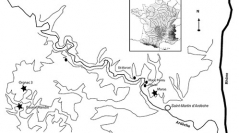

 Comptes Rendus Palevol
7 (5) - Pages 315-325
Comptes Rendus Palevol
7 (5) - Pages 315-325The Baume Flandin, located in the Middle Rhone valley, yielded in the 1950s an archaeological level attributed to the Middle Palaeolithic, with abundant elongated flakes. This feature is rare in southern Europe before MIS 4. The cave was totally excavated and little evidence existed to confirm the date of this level, which was attributed to the ‘Riss–Würm’ according to the fauna remains and the sediments. New fieldwork took place in 2005, in front of the cave entrance, on the terrace. The study of the archaeological level that has been discovered brings new information on the age of the sequence of this site. The human occupation took place in the latest interglacial, at the end of isotopic stage 5e. This date leads us to revive the debate on the first evidence of the laminar debitage between northern and southern Europe.
Southeastern France, Middle Palaeolithic, Stratigraphy, Paleontology, Paleoenvironment, Human occupation